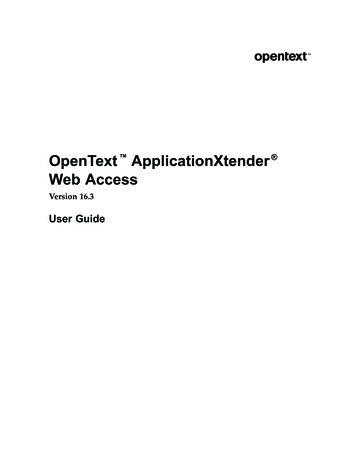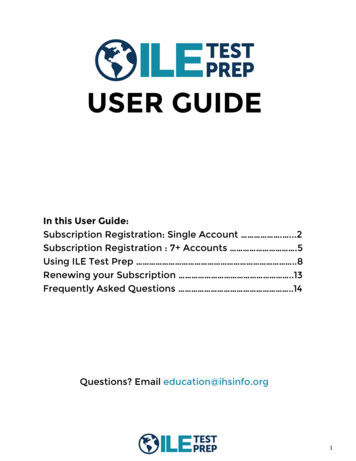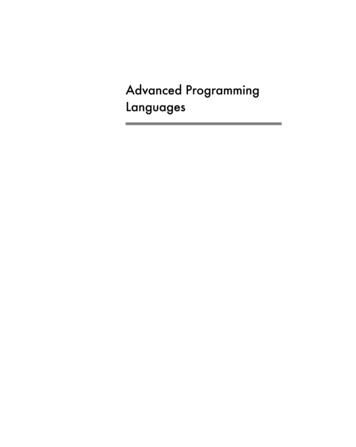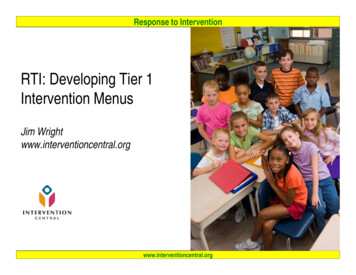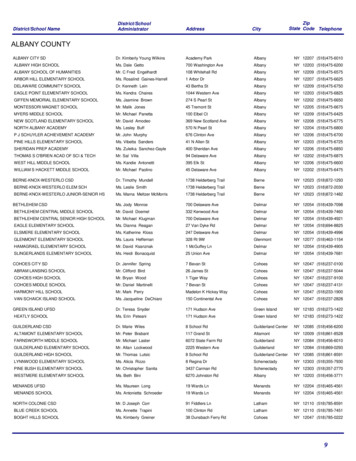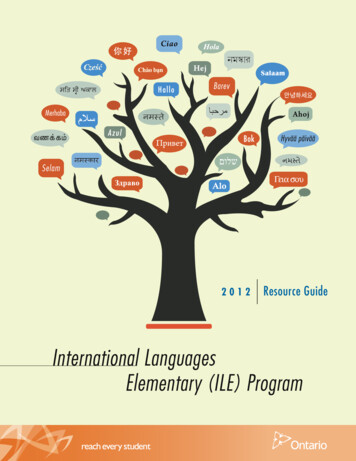
Transcription
שלום 2012Resource GuideInternational LanguagesElementary (ILE) Program
1ContentsAbout This Guide21. Why Ontario Communities6. ILE Instructors29Selecting ILE Instructors29Professional Development for ILE Instructors31Need an ILE Program3The Benefits of Multilanguage Learning47. Parents, Volunteers, and2. What We Know about ILE Students5Community Partners33What Parents Can Do33What Volunteers Can Do36What the Community Can Do37Meeting the Needs of Students63. Roles of Participants in anILE Program7Ministry of Education7School Board Senior Administrators and Trustees 7Program Administrators8Field Coordinators, Curriculum Supervisors,8. Responsibilities within theILE Classroom40Responsibilities of ILE Instructors40Responsibilities of ILE Students43and Site Administrators89. Classroom Resources44Day School Staff8Planning an ILE Program44ILE Instructors9Creating a Welcoming and Safe LearningParents and the Community9EnvironmentILE Students9Developing Language Teaching Strategies4. Starting an ILE Program1049and Approaches52Engaging Students in Their Learning61Weekend Programs11Integrated Extended-Day Programs12After-School Programs14Late-Afternoon and Evening Programs15Before-School and Lunchtime Programs16Summer School Programs17Resources for Planning7318Resources for Managing Classroom Dynamics80Resources for Language Instruction845. Running a Successful ILE ProgramThe School Board18Field Coordinators, Curriculum Supervisors,and Site Administrators22The Principal24School Office Staff26Custodial Staff27Day School Teachers27Finding, Developing, and Evaluating Resources 63Assessing and Reporting on Student Progress68Planning for Professional Development7210. Instructor Resources73Glossary104References108Une publication équivalente est disponible en français sous le titre suivant : Programme de langues internationales au palier élémentaire, 2012This publication is available on the Ministry of Education’s website, at www.ontario.ca/edu.
About This GuideThis resource guide will help you to plan and deliver the InternationalLanguages Elementary (ILE) program in your community. It is designed forboth administrators and instructors and contains information on these topics: why Ontario communities need an ILE programwhat we know about ILE studentswho participates in an ILE program and what their roles arehow to start an ILE programhow to run a successful ILE programhow to choose ILE instructors and provide them with professionaldevelopment what the responsibilities of instructors and students are inside theILE classroom how to form partnerships with parents,1 volunteers, and communitiesIn addition, the guide includes a wide range of resources in the ClassroomResources and Instructor Resources sections. These will give ILE instructorsthe tools they need to offer students a successful and rewarding classroomprogram.The program discussed in this guide applies to all languages other thanCanada’s official languages. It is open to all students in elementary schoolsin Ontario whose parents want them to learn a language in addition toEnglish or French, where enrolment numbers permit.Schools that succeed in bringing issues related to cultural and linguisticdiversity from the periphery to the centre of their mission are much morelikely to prepare pupils to thrive in the interdependent global societywithin which they will live. These schools will communicate to pupils andcommunities that their access to more than one culture and language is aresource that can enrich the entire school.Jim Cummins, “Cultural and Linguistic Diversity in Education: A Mainstream Issue?”, 1997.1. In this document, the term parent(s) is used to refer to both parent(s) and guardian(s).2
1Why Ontario CommunitiesNeed an ILE ProgramThe International Languages Elementary (ILE) program has evolved overthe years. It began as a way to help Ontario elementary school studentsmaintain and develop their heritage language, or first language. Today,students enrolled in ILE have a variety of linguistic and cultural backgrounds.They participate in the program for numerous reasons. This program has playeda vital role in the lives of many young Ontarians and continues to do so.A broad history of the ILE program contains several landmark developments:1969 The Royal Commission on Bilingualism and Biculturalism releases itsreport.1971 The federal government sets out its policy of multiculturalism andforms the Non-Official Languages Study Commission.1977 The Ontario government introduces the Heritage Languages Program, to be administered through the continuing education departments of school boards.1989 Legislation is passed to govern non-official language programs inelementary schools.1990 The Ministry of Education issues Policy/Program MemorandumNo. 7, “Heritage Languages Program”, June 29, 1990.1991 The ministry releases the Heritage Languages, Kindergarten to Grade 8resource guide.1993 The Heritage Languages Advisory Work Group releases its report.The Heritage Languages Program becomes the International Languages Program (Elementary).1995 The ministry releases the International Languages Program (Elementary) resource guide. The guide outlines considerations for boards,schools, and instructors in planning and developing an ILE program.3
4The InternationalLanguages Educators’Association of Ontariohas identified four pillarsof international languageeducation: languagelearner support, identity,personal growth, andcareer enhancement.International Languages Elementar y (ILE) ProgramThe Benefits of Multilanguage LearningFamilies choose ILE to enhance the overall education of their children inmany ways.The program gives students an opportunity to develop their first language andallows heritage languages to flourish. This can help students to communicatewith members of their family and community. The program can also deepentheir cultural awareness, foster pride in their heritage, and strengthen theirself-esteem and self-image. Students also feel more included in their schoolswhen they see their identity reflected in school programs.You can find materialsabout the benefits oflearning languagesat www.ilea.ca.Also, in an increasingly interdependent world, bilingual or multilingualindividuals are in demand and their skills can greatly benefit society. The ILEprogram helps all students to communicate more effectively with people ofdiverse backgrounds. It builds language skills that they will be able to uselocally, nationally, and globally, giving them more opportunities to representCanada in the global village.Finally, research has shown that students who study languages in addition toEnglish and French perform better in other school subjects. As well, whenstudents develop both their first language and other languages, their overallintellectual functioning improves.Students with well-developed skills in their first language have been shownto acquire an additional language more easily and fully and that, in turn,has a positive impact on academic achievement.Fred Genesee, Kathryn Lindholm-Leary, William Saunders, and Donna Christian,Educating English Language Learners: A Synthesis of Research Evidence, 2006.If we want that part of our country which is humane and tolerant to continueon into the future, we need to educate the next generation to be tolerant,open. What better way to do this than through learning languages?Roseann Runte, “Surviving the Perils of Politics:The Language Classroom of the Next Century”, 1996.
21What We Know aboutILE StudentsILE students have a range of experience. Some students entering theprogram have no previous knowledge of the target language. Of these,some have no ancestral link to the language but may simply wish tostudy it to enrich their lives. Others are second- or third-generationCanadians whose cultural background is related to the target languagebut who have never learned it.At the other end of the spectrum, some students have a high degree ofcompetence in the language of study. They are new to Canada, or have hadmore opportunity to use the language than other learners have. For instance,their parents may have encouraged the use of the language at home or inthe community.Many students fall somewhere between these extremes. Some speak or hearthe target language at home to an extent. Some have learned the languageearlier but not maintained it; they may want to recover it or their parentsmay be eager for them to do so. Some wish to improve their knowledge ofthe language and ability to use it. These students’ competence and learningneeds will vary.Some children may have learned both English and French to a degree andhave some ability in other languages as well. When these students come toschool, their competence in each of these languages is likely to differ. Also,they may understand more than they can express in the target language.Instructors need to be aware of students’ prior comprehension as itprovides a foundation for building their competence in the language.5
6International Languages Elementar y (ILE) ProgramOther students have learned a variety (or dialect) of the target language.Because their identity and self-esteem are tied to their language use andother people’s reactions to it, instructors should accept the variety whilealso presenting and modelling a standard version of the language.Meet some ILE studentsAhab is a newcomer to Canada. He has limited schooling in his country oforigin. The goal for this student is to further his education in first-languageliteracy.Svetlana was born and raised in Canada. Her family is in regular contactwith relatives abroad. This student wants access to her culture of origin.Miriam’s parents realize that we are in a global community. They want herto improve her chances for career success by learning other languages.Marc was born and raised in Canada. He is interested in learning thelanguage of his friends who speak another language and in learning abouttheir culture.Meeting the Needs of StudentsIn addition to having a range of language abilities and backgrounds, ILEstudents are diverse in many other ways: developmental stage, such as age and stage of readinesslearning stylelearning strengths and needsethnocultural backgroundSchool boards are responsible for delivering a program that meets the needsof all types of students and fulfils the goals of Ontario education. The goalsare as follows: to help all students improve their learning and achievement to close the achievement gap between learners to increase public confidence in education
31Roles of Participantsin an ILE ProgramThe ILE program is an important educational experience and opportunityfor students. It is also a core part of the academic, social, and culturalfabric of communities across the province. Several stakeholders are keyto the success of the program. This section identifies the main participantsand describes their respective roles.Ministry of EducationThe role of the ministry is to: set policies and guidelines for all education in Ontario;establish a theoretical framework for all educational programs;mandate and fund ILE programs for elementary schools;provide guidelines for program practice.School Board Senior Administrators and TrusteesSuperintendents, directors of education, and trustees have several responsibilities. Their role is to: put a system in place for promoting, operating, and supervising the program; make arrangements for the staff, technology, and facilities necessary torun an accountable program; ensure the program is delivered in a way that meets the ministry mandate; apply ministry grants for program instruction, assessment, and supervision.7
8International Languages Elementar y (ILE) ProgramProgram AdministratorsPrincipals, managers, and program consultants form the school board’sprogram administration. Their role is to: act as a bridge between the ILE program and other departments andschools within the school board and in the community at large; lead program development and liaise with other ILE providers withinthe region and throughout Ontario; oversee all program operations, including coordination, instruction,and community and school relations; provide guidance and direction in pedagogy and staff development.Field Coordinators, Curriculum Supervisors,and Site AdministratorsThe role of field coordinators, curriculum supervisors, and siteadministrators is to: lead program development in terms of curriculum, instruction,and assessment; maintain contact with staff, community representatives, parentsand caregivers, and day school staff; foster parent engagement that supports student learning at homeand at school; manage all aspects of the on-site delivery of the program before,during, and after class; ensure the safety and well-being of students and staff.Day School StaffThis category includes day school administrators (principals and viceprincipals) and teaching staff, custodial staff, and curriculum and resourceteachers. Their role is to: communicate with families and promote the services of the ILE programto them; maintain contact with ILE staff to support the program and its studentsin such areas as English as a second language instruction, special education,human resources, and communications; share space, resources, and best practices with ILE colleagues.
Roles of Participants in an ILE ProgramILE InstructorsThe role of ILE instructors is to: plan, deliver, and coordinate a program that is optimal for languagelearning and that reflects current teaching practices in Ontario; ensure the safety and well-being of students; communicate about student progress to administrators, other educators,parents, and students themselves; encourage parent involvement in student learning at home and at school.Parents and the CommunityThe role of parents and other members of the community is to: promote and support the ILE program within the community at large; work cooperatively with school board and program staff to enhance theILE program; culturally enrich the program by being active partners with ILEinstructors; volunteer within the program in line with school board procedures.ILE StudentsThe role of ILE students is to: attend classes and meet the requirements set by instructors; communicate with program staff about personal matters that affecthow much and how well they learn, such as learning styles, interests,and challenges; share responsibility for their own learning with instructors andprogram staff; participate in classes following a code of conduct similar to any othereducational program, such as showing respect for others and forschool property.9
41Starting an ILE ProgramThe responsibility for creating and maintaining ILE programs rests withthe publicly funded school boards, which are mandated to do so by theMinistry of Education. If a school board receives a request from thecommunity for language instruction in which at least 23 students want toparticipate, it must offer an ILE program.A board may also determine other reasons that such a program would benefitstudents. For example, the board may decide to offer a particular program forvery few students because it is the only one for that language within the region.To create a balance within its overall allocation of resources, the board mayalso offer programs for which demand is greater and enrolments are larger.This section outlines the considerations involved in choosing the right modelfor a successful ILE program. The following are the most common modelsfor ILE learning: weekend programsintegrated extended-day programsafter-school programslate-afternoon and evening programsbefore-school and lunchtime programssummer school programsSchool boards must offer the program for a maximum of 2.5 hours per weekin each case, or 2.5 hours per day during the summer.School boards are encouraged to work with other schools, other boards, andthe community at large to: provide the types of programs that will best serve their ILE students;10
Starting an ILE Program ensure that school and classroom facilities are appropriate; avoid costly duplication of services.Weekend ProgramsThe weekend model has been the most popular program format over theyears because it allows parents and the community to be more engaged.Classes are usually offered once a week on a Saturday or Sunday and canattract students from areas outside the school community. Students thinkof the site of a weekend ILE program as their language school.In choosing a location for weekend classes, boards need to consider whethera facility is the best fit for the students enrolled in the program. For instance,the physical environment of elementary schools is better scaled to the needsof elementary-age students. It is also important to ensure that ILE programsare given equitable access to any school board property, resources, and equipment necessary to enrich the learning experience.AdvantagesA weekend program has many benefits: It encourages the use of school facilities by the whole community. It is accessible to students from a wide geographical area. It may be the only means by which very small linguistic communities cangain access to a language program. It offers the members of a linguistic community an opportunity to engagein a common activity. It attracts community volunteers who are not available during the week. It often makes it possible to recruit staff more easily than other models do. It may attract enough students to allow classes to be structured by gradelevels, permitting age-appropriate placement of learners to match their needs. It allows students to attend when they are rested rather than tired fromthe school day.In general, a weekend program provides opportunities to extend languagestudy into other community activities and allows school boards to run severallanguage programs at one site. Adult programs related to language or culturethat are run concurrently, for example, could encourage the involvement ofwhole families in language learning and help to create an environment thatpromotes intercultural exchange.11
12International Languages Elementar y (ILE) ProgramChallengesA weekend program may present some challenges: School boards may need to provide alternative on-site administrative andsupport staff. Administrators may find it complex to establish and maintain continuitybetween the day school program and the language program. The day school principal and staff may not feel significant interest in andownership of the program. Students may find that having week-long intervals between classes slowstheir development of proficiency in the language.It is suggested that day and weekend school staff conduct meetings to discussand address these issues.Try this!Day school staff can take various simple measures to show their commitmentto ILE. For instance, they can ensure that the program is visible throughoutthe week by disseminating information about it to both students and parentsand by sharing: bulletin boards;school newsletters;storage space;multilingual materials.When students see their day schools recognizing their weekend languageprograms, they feel that their studies and/or heritage are validated.Integrated Extended-Day ProgramsLanguage classes may be offered during the school day if it is extended by30 minutes for all children within the school. This extension enables schoolsto meet the requirement for five hours of curriculum instruction.The integrated extended-day model works best when the local school community is involved in the decision to adopt the program and all children withinthe school are encouraged to participate, ideally so that students can beplaced in age-appropriate classes. Offering the program during the regular
Starting an ILE Programschool day gives it a higher profile and permits ILE instructors to take cuesfrom what students are doing in other subject areas as they develop themesfor their own classes.To protect the integrity and control the cost of the ILE program in thisformat, boards are encouraged to develop guidelines for student exemptions.For instance, they may set a deadline for students to ask to be exempted fromthe program.AdvantagesAn integrated extended-day program has several benefits: It improves the relationship between the school and the local community. It recognizes children’s linguistic and cultural backgrounds and enhancesthe image of the community’s languages within the school. It encourages all students to participate in both language learning andcross-cultural sharing within the school. It gives language learning the same status as other curriculum areas. It furthers language learning by increasing opportunities for studentsto use the target language regularly. It strengthens the day school’s commitment to and ownership of theILE program. It encourages interaction between the day school staff and the ILEinstructors. It allows ILE instructors to become familiar with the school programas a whole. It permits language classes to be taught at any time within the extendedschool day. It may enable the same ILE instructor to handle several classes throughout the day, providing the program with a better flow.Overall, the model encourages students’ acceptance of language learningand strengthens their interest and sense of commitment by offering dailyexposure to the target language within the regular school setting.ChallengesAn integrated extended-day program may present some challenges: Implementation requires the school board to carry out extensive consultation with both school staff and the community. It extends the instructional day for all students and staff at the school,whether or not they are involved in the language program.13
14International Languages Elementar y (ILE) ProgramAfter-School ProgramsLanguage instruction may be offered immediately following the regularschool day. In most cases, students who attend such a program are enrolledin day school at the same location or at a nearby school within easy walkingdistance.Most schools schedule a break of 15 to 30 minutes between the end of regularclasses and the beginning of the language class. The break gives students timeto get to language classes offered at a nearby school or community centre andnot available at their own day school.Because language programs are offered by a school board, board policiesand procedures for the regular school program apply to after-school classes.These classes are usually under the jurisdiction and responsibility of the dayschool principal.AdvantagesAn after-school program offers a number of benefits: It strengthens links between the school and the local community, advancingthe school’s role as a community focal point. It directly addresses not only the needs of students in a particular schoolbut also those of students from other schools. It recognizes students’ linguistic and cultural backgrounds and enhancesthe image of language study within the school, encouraging all studentsto participate in both language learning and cross-cultural sharing. It promotes the effective use of school resources and equipment. It encourages the day school principal and staff to feel ownership ofand commitment to the program. It facilitates communication and interaction between day school andlanguage program staff, improving continuity and enabling the classroomteacher and the ILE instructor to discuss students’ learning needs. It frees students to engage in other activities in the evening and onweekends. It allows classes to be held with the frequency that best supportsstudent learning.Overall, the after-school program model can strengthen students’ sense ofbelonging to and interest in their school. This is especially true if a programis offered in the first or heritage language of many students in the school.
Starting an ILE ProgramSuch a program also enables English language learners to develop literacy intheir first language. The after-school model can also enhance the reputationand profile of the school within the community. For example, a school mightoffer an after-school international language program to enrich its overallprogram or to strengthen links to an international project or partner.ChallengesAn after-school program may present some challenges: The potentially low number of students from small catchment areas maymake it necessary to accommodate a wide range of ages and abilitieswithin each class. Students’ ability to participate in after-school co-curricular activities maybe reduced.Late-Afternoon and Evening ProgramsThe day program and language classes may be separated by a longer breakthan in the after-school model. The late-afternoon and evening model allowsstudents enough time to go home and return to school or another facilitywhere language classes are held, or to travel from schools some distance away.Late-afternoon and evening classes are often longer than 30 minutes and maybe held once, twice, or three times a week.AdvantagesA late-afternoon or evening program offers a number of benefits: It makes it possible to run concurrent adult programs or communityactivities. It can attract children from a larger catchment area, increasing the numberof students and making it easier to place them in age-appropriate classes. It provides language classes with access to a wider range of facilities,resources, and equipment than other models because they do not have tocompete with as many co-curricular activities as after-school programs do. It gives students a break after the regular school day that may benefittheir learning. It may make it easier to recruit qualified ILE instructors who are unavailable during the day.15
16International Languages Elementar y (ILE) ProgramGenerally, this model often gives more parents and community membersaccess to the ILE program, encouraging the participation of whole familiesand community organizations.ChallengesA late-afternoon or evening program may present some challenges: The school board may need to provide alternative on-site administrativeand support staff. The day school principal and staff may not feel significant interest in andownership of the program. ILE students may not have as much opportunity to use the target languageas students in other models do, depending on the frequency of classes. The structured day may be unduly long for young students.Before-School and Lunchtime ProgramsLanguage classes can be offered either before the start of the regular schoolday or during the lunch period where local needs make it difficult to offerother models. This type of program can include students who are not ableto participate in programs offered at other times or in other locations.AdvantagesA before-school or lunchtime program offers some specific benefits: It ensures that administrative and support services staff are available. It may be offered to Junior and Senior Kindergarten students enrolledin half-day morning programs, as a 30-minute class before they returnhome for lunch. It is accessible to rural students who must catch buses scheduled immediately before and after school and can attend language classes only duringthe lunch period. It may enable students who take part in co-curricular activities to participate in ILE as well. It can accommodate an ILE instructor who is free only before school orduring lunch or a day school staff member who also teaches the ILEprogram.A before-school or lunchtime program also shares many of the advantagesof the after-school and integrated extended-day programs.
Starting an ILE ProgramChallengesA before-school or lunchtime program may present some challenges: The number of staff available at the required times may be limited. Students who do not have a significant break at lunch time may notfunction at their best in their day school program during the afternoon.Summer School ProgramsLanguage classes may be offered as a summer program for up to 2.5 hourseach day. The school board sets the times, location, and duration of theprogram in cooperation with the community. The student body generallycomprises both new students and those from the previous school year.AdvantagesA summer school program offers specific benefits: It allows the community and the school board to explore options to offer afull-day educational program in the target language, such as morning ILEclasses combined with fee-based cultural or leisure activities in a summercamp format in the afternoon. It offers access to school resources and equipment that are often unavailablein other organizational models. It gives students an option for language learning during the summer. It permits ILE instructors to develop themes in depth.A summer school program offers students an intense focus through dailyclasses to improve language learning. It can include alternative culturalactivities and events not possible during the regular school year.ChallengesA summer school program presents unique challenges: Students who participate in a language program only in the summer mayfind it difficult to maintain their learning from one year to the next. Where the language program is the only class taking place in a schoolduring the summer, school boards have to make special arrangementsto supervise students, provide access to the building, and respond toemergencies or accidents.17
15Running a SuccessfulILE ProgramT his section examines the roles and responsibilities of thoseinvolved in running an ILE program:the school boardfield coordinators, curriculum supervisors, and site administratorsthe principalschool office staffcustodial staffday school teachersThe roles and responsibilities of ILE instructors are discussed in depth laterin this guide.The School BoardSc
The Benefits of Multilanguage Learning 4 2. 5What We Know about ILE Students Meeting the Needs of Students 6 3. Roles of Participants in an ILE Program 7 Ministry of Education 7 School Board Senior Administrators and Trustees 7 Program Administrators 8 Field Coordinators, Curriculum Supervisors, and Site Administrators 8 Day School Staff 8

